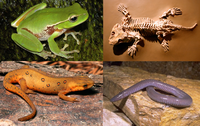
Photo from wikipedia
The Argentine hake Merluccius hubbsi is an important fishery resource of the Southwestern Atlantic Ocean and it is also a potential species for cultivation. In this work, the digestive system… Click to show full abstract
The Argentine hake Merluccius hubbsi is an important fishery resource of the Southwestern Atlantic Ocean and it is also a potential species for cultivation. In this work, the digestive system development in field‐caught hake larvae was studied using histological and histochemical approaches. The digestive tract of larvae was divided into: oropharyngeal cavity (OPC), esophagus, stomach (that develops in the preflexion stage), and intestine. The annexed digestive glands consisted of the liver and the exocrine pancreas. At the beginning of the preflexion stage, teeth were developed in the OPC. There were mucous cells in the esophagus secreting different glycoconjugates from hatching. The enterocytes in the posterior intestine exhibited supranuclear vesicles associated with protein absorption. Mucous cells were observed in the posterior intestine in the preflexion stage and, in the anterior region, ending the flexion stage. Each type of glycoconjugates has a specific role. Acidic mucins lubricate and protect from mechanical damage, sialomucines protect from bacterial infections and neutral mucins regulate the acidity of mucus secretion, protect against abrasion and participate in the formation of the chyme, indicating a pregastric digestion. The liver was present since hatching with pancreatic tissue inside and increased in size acquiring the typical structure with hepatocyte cords, sinusoids, vacuoles, and hepatic duct. The hepatocytes vacuolization increased with larval development. The pancreas became extra‐hepatic, with basophilic acinar cells and acidophilic zymogen granules. Throughout the ontogeny, the increased structural and functional complexity of the digestive system reflected the transition to exogenous feeding and nutritional increasing needs.
Journal Title: Journal of Morphology
Year Published: 2020
Link to full text (if available)
Share on Social Media: Sign Up to like & get
recommendations!